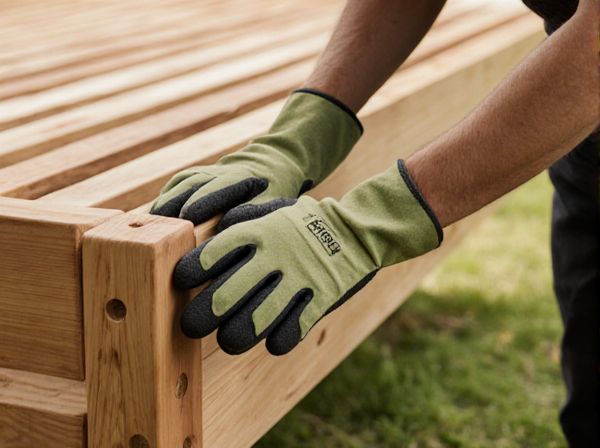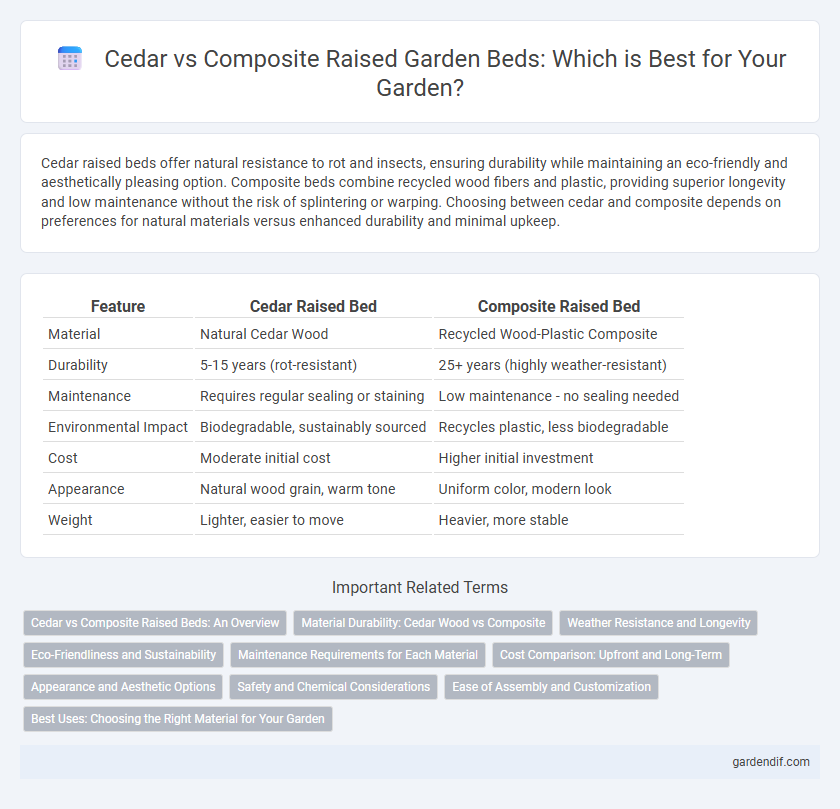
Cedar bed vs Composite bed Illustration
Cedar raised beds offer natural resistance to rot and insects, ensuring durability while maintaining an eco-friendly and aesthetically pleasing option. Composite beds combine recycled wood fibers and plastic, providing superior longevity and low maintenance without the risk of splintering or warping. Choosing between cedar and composite depends on preferences for natural materials versus enhanced durability and minimal upkeep.
Table of Comparison
| Feature | Cedar Raised Bed | Composite Raised Bed |
|---|---|---|
| Material | Natural Cedar Wood | Recycled Wood-Plastic Composite |
| Durability | 5-15 years (rot-resistant) | 25+ years (highly weather-resistant) |
| Maintenance | Requires regular sealing or staining | Low maintenance - no sealing needed |
| Environmental Impact | Biodegradable, sustainably sourced | Recycles plastic, less biodegradable |
| Cost | Moderate initial cost | Higher initial investment |
| Appearance | Natural wood grain, warm tone | Uniform color, modern look |
| Weight | Lighter, easier to move | Heavier, more stable |
Cedar vs Composite Raised Beds: An Overview
Cedar raised beds offer natural resistance to rot and insects, providing durability without chemical treatment, while composite raised beds combine recycled wood fibers and plastic for enhanced longevity and minimal maintenance. Cedar beds typically have a warm, natural aesthetic with a lifespan of approximately 10-15 years, whereas composite beds can last 25 years or more but often come at a higher initial cost. Both options provide sturdy gardening solutions, with cedar favored for organic appeal and composites chosen for long-term durability.
Material Durability: Cedar Wood vs Composite
Cedar wood raised beds offer natural resistance to rot, insects, and weather, ensuring durability for up to 10-15 years with proper maintenance. Composite raised beds are made from a blend of recycled wood fibers and plastic, providing superior resistance to moisture, decay, and UV damage, with lifespans often exceeding 20 years and minimal upkeep. While cedar offers natural aesthetics and eco-friendliness, composite materials excel in long-term durability and low maintenance requirements.
Weather Resistance and Longevity
Cedar raised beds offer natural weather resistance due to their inherent oils that repel moisture, insects, and decay, typically lasting 10 to 15 years with minimal maintenance. Composite raised beds, made from recycled wood fibers and plastic, provide superior weather resistance by resisting rot, warping, and insect damage, often outlasting cedar with a lifespan of 20 to 25 years. Choosing between cedar and composite depends on balancing natural aesthetics and moderate longevity against higher durability and extended lifespan in diverse climates.
Eco-Friendliness and Sustainability
Cedar raised beds are naturally resistant to rot and insects, making them a durable and eco-friendly choice without the need for chemical treatments. Composite beds, made from recycled plastics and wood fibers, offer sustainability by reducing waste and requiring minimal maintenance, but their production involves energy-intensive processes. Choosing cedar supports biodegradability and lower environmental impact, while composite beds provide long-term durability and resource recycling benefits.
Maintenance Requirements for Each Material
Cedar raised beds require regular maintenance such as annual sealing or staining to prevent weathering, insect damage, and wood rot, typically lasting around 10-15 years with proper care. Composite raised beds are low-maintenance, resisting rot, insects, and decay without the need for sealing or staining, offering durability for 25-30 years. The choice between cedar and composite materials hinges on willingness for upkeep versus long-term durability with minimal effort.
Cost Comparison: Upfront and Long-Term
Cedar raised beds typically have a higher upfront cost due to the premium quality and natural resistance to rot, averaging $50 to $100 per bed, while composite beds range from $40 to $80 but can incur additional maintenance expenses. Over the long term, cedar beds require less upkeep and maintain structural integrity for 15-20 years, whereas composite beds might need replacement or repairs within 10-15 years despite their low initial maintenance. Cost efficiency favors cedar for durability, but composite beds offer a budget-friendly option with moderate lifespan and repair considerations.
Appearance and Aesthetic Options
Cedar raised beds offer a natural, warm appearance with rich reddish hues that age gracefully to a silver-gray patina, enhancing garden aesthetics over time. Composite raised beds deliver a clean, uniform look with a variety of color and texture options that resist fading, ensuring consistent visual appeal year-round. Both materials allow customization, but cedar's organic charm contrasts with composite's modern, maintenance-free design.
Safety and Chemical Considerations
Cedar raised beds are naturally resistant to rot and insects, making them a safer choice without the need for chemical treatments, which can leach harmful substances into the soil and plants. Composite beds are made from recycled plastics and wood fibers, providing a toxin-free alternative but may contain additives or binders that require checking for food-safe certifications. Choosing cedar ensures organic safety, while composites offer durability with careful attention to chemical composition for garden health.
Ease of Assembly and Customization
Cedar raised beds offer natural wood that is lightweight and easy to cut, allowing for straightforward assembly and flexible customization to fit specific garden dimensions. Composite raised beds, made from durable recycled materials, often come with pre-cut panels and interlocking parts, simplifying setup but limiting size modifications. Choosing cedar supports personalized design with hand tools, while composite provides quick installation with fixed configurations.
Best Uses: Choosing the Right Material for Your Garden
Cedar raised beds are ideal for organic gardening due to their natural resistance to rot and insects, providing a chemical-free option that enhances soil health. Composite raised beds offer durability and low maintenance, best suited for urban gardens or areas with harsh weather conditions where longevity and minimal upkeep are priorities. Selecting between cedar and composite materials depends on factors such as gardening style, environmental exposure, and desired lifespan of the raised bed.
Cedar bed vs Composite bed Infographic

 gardendif.com
gardendif.com